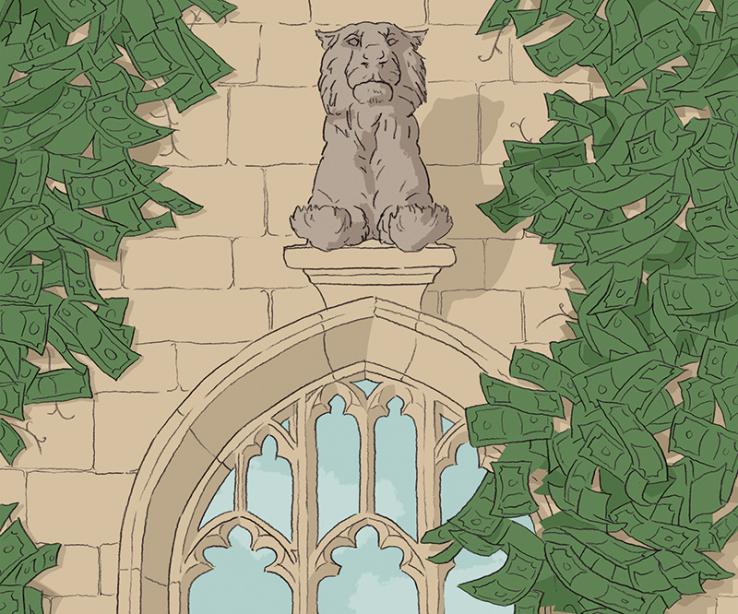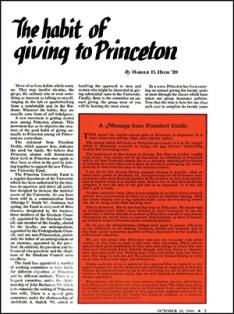For the past few years, over Fourth of July weekend, Peter Ryan ’07 and his father, Tom, have gotten together on Cape Cod for family bonding and some good-natured one-upsmanship. The annual giving campaigns at Princeton and Holy Cross, Tom’s alma mater, close on June 30 and that is a big deal in the Ryan family. Both men are longtime giving chairs for their respective classes; Tom, in fact, once served as the Crusaders’ development director. So, to make things a little more, you know, interesting before the final numbers come out, they place a friendly wager: Whoever’s class had the lower participation rate that year pays for breakfast.
Holy Cross alums are famous for their loyalty, but Peter wins the bet more often than not. The commitment of its alumni makes Princeton the envy of other colleges. But lately, both Ryans have been concerned. Whether they have cause to feel that way depends on how one looks at annual giving. Princeton set another record last year, raising a whopping $81.8 million, $13 million more than it raised in 2021. Except for occasional dips, such as during the 2008 recession, the total dollar amount raised by the University has been on a steady upward trajectory.
To see a glass half empty, though, look at the participation rate, which has been moving in a different direction. Consider a few examples:
- As recently as 2015, more than 60% of Princeton’s undergraduate alumni supported the Annual Giving campaign, but that number has fallen in seven out of the past eight years and has not cracked 50% since 2019.
- Over the past 15 years, Peter Ryan’s Class of 2007 has seen its participation rate drop from 75% to 62%, even though last year was a major reunion for the class.
- Fifty-two percent of the Class of 2018 gave when its members graduated, but only 30% gave in 2022.
- Taking a longer view, the five youngest classes gave at an average rate of 58% in 2000 but only 31% percent last year.
“We’re looking at a phenomenon that’s not a Princeton-specific phenomenon, and I think we have to keep that in mind as we try to understand it and respond to it,” President Christopher Eisgruber ’83 told PAW in March. “But we do want to understand and respond to it in a strong way.” (Up at Holy Cross, Tom Ryan’s Class of ’76 fell below 60% participation last year for the first time. “That killed me,” he says.)
Though the Annual Giving office, part of University Advancement, has a paid staff of 25 and provides critical support, Princeton’s AG campaigns are driven by more than 3,000 alumni volunteers, usually classmates contacting fellow classmates asking, can you at least give something. Though many make larger gifts, it is the smaller donations, sometimes known as “numeral gifts” (someone in the Class of 1992 giving $92, for example) that add up. AG donations are also unrestricted — unlike much of the endowment, which is earmarked for specific programs — and can be channeled wherever the trustees believe the need is greatest. In that sense, notes longtime volunteer Deb Yu ’98, “Annual Giving participation is a vote of confidence in the University, almost an approval rating.”
“If you look at Harvard’s undergraduate participation, it’s garbage! Yale’s is the same. I’ve always relished the fact that Princeton put up such high numbers. It’s like, yeah, we do love our school more than you do.”
— Peter Ryan ’07
Those alumni who give do so for many reasons. Many want to support programs such as financial aid, usually one of the biggest recipients of Annual Giving dollars. Others give out of a sense of gratitude or responsibility. “Everyone who has gone to Princeton has received a tremendous benefit, whether they were on scholarship or not,” insists Tina Ravitz ’76 . “If you’ve ever put ‘Princeton University’ on your résumé, you need to give something.”
Don’t underestimate pride as a motivator, too. “If you look at Harvard’s undergraduate participation, it’s garbage!” Peter Ryan scoffs. “Yale’s is the same. I’ve always relished the fact that Princeton put up such high numbers. It’s like, yeah, we do love our school more than you do.” Ryan has the numbers to back him up. In 2020, U.S. News & World Report published a list of “10 Colleges Where the Most Alumni Donate” and Princeton came out on top, with a two-year giving average of 55%. Dartmouth was the only other Ivy League school on the list, at 44%. (Relatively few universities publish their participation rates, usually preferring to emphasize the dollars raised.)
Whatever their reasons, fewer Princetonians seem committed to giving than a decade ago. The trend, if it continues, could signal some weakening of that rabid alumni spirit for which the University has long been famous. So, this year, entering the final, frenzied month of June, the Annual Giving leadership has set an overall participation goal of 50%, with an ambitious 55% average participation rate for the four youngest classes.
But, as Eisgruber notes, Princeton is battling headwinds, many of them national, societal, and generational. The recent decline in participation may prove to be a hangover from the disruptions of COVID and the unrest that has gripped the campus and the nation over the past decade. It could be a response to the massive growth of the endowment, which has nearly doubled in value in the past decade. Or it might just be cyclical, a passing phase.
But with so much at stake, that would seem like a risky bet to make.
Princeton spotted Yale a 50-year head start in annual giving but moved up quickly. The Elis invented the collegiate annual giving campaign in 1890, followed by Cornell in 1908, Dartmouth in 1915, and Harvard in 1925. Princeton didn’t inaugurate its own effort until 1940.
At a time when the endowment was miniscule, the Princeton University Fund, as it was called, helped balance the budget, but from the outset, participation was emphasized as much as dollars. Annual Giving, President Harold Dodds *1914 declared in that first year, provided “an opportunity for all Princeton men, no matter what their financial position at the moment, to join in an expression of loyalty when it is needed most. Believe me ... it isn’t the size of the gift that is so important. It is the fact that a gift is made.”
Nevertheless, it took time to build a culture of giving. That inaugural campaign remains the weakest in Princeton history, with just 18% participation, the gifts ranging in size from 10 cents to $1,000, as well as two tickets to the Yale football game for resale. The participation rate had nearly tripled by the time individual class campaigns began shortly after World War II.
Though the campaigns were broadened to include parents (1948-49), corporate matching gifts (1954-55), and graduate alumni (1957-58), gifts by undergraduate alums have always been the largest component of Annual Giving. Undergraduate participation topped 70% for six straight years in the late 1950s and early ’60s, setting a record of 72% in 1958-59. Since its inception, Annual Giving has raised more than $1.6 billion from all sources, and nearly 90% of undergraduate alumni have given at least once. Edward Simsarian ’45, the current record holder, has contributed to Annual Giving for 76 years.
All this helps explain the envy that Tom Ryan and other development directors feel. Almost everywhere else, things are different. According to a 2018 report by Hanover Research, only about 18% of alumni of private colleges and universities donate to their alma maters, and only 5% of alumni of public universities do.
However, the report also found that, while the total dollar amount of private donations is going up, those dollars are coming from fewer donors. “Alumni fundraising participation and institutional donor acquisition rates are dropping,” Hanover says, “and institutions increasingly rely on mega-donors to hit fundraising goals.” A 2019 report by the American Council on Education detected a similar trend. “Beyond large gifts, philanthropy to higher education has benefitted from gifts of all sizes and from donors of all income levels,” it said. “However, beginning around the time of the Great Recession, participation rates have declined considerably in recent years.”
This trend can be seen elsewhere. To pick just a few examples, Bowdoin’s overall participation rate fell from 52% in 2019 to 43% in 2022. Holy Cross’ fell from 50% to 39%. And in a 2020 report, Yale’s five youngest classes all had less than 14% participation, and none of its youngest 25 classes was above 25%.
Before considering the reasons for the decline in participation, it is important to keep a few points in mind. First, the recent dip notwithstanding, Princeton still fares far better than nearly anyone else. Second, undergraduate enrollment is growing, which means that in the future it will require more donors to get 60% participation from, say, the 1,500-member Class of 2026 than it did from the much smaller classes of earlier generations.
That said, four factors seem to be driving the current downturn:
1. COVID. In March 2020, with minimal warning, the University sent students home and cancelled Reunions. The Annual Giving office also curtailed outreach efforts during the critical final months of the campaign and, not surprisingly, giving suffered. While the total dollar amount raised slipped by $2.3 million (but was still the fourth-highest total), alumni participation slumped by seven-and-a-half points to 48%, the largest single-year drop ever. Last year, even with the economy recovering and the campus reopened, participation was just 47%.
The youngest classes, which had seen their time on campus cut short, were the most affected. Only 21% of members of the Class of 2021 participated in their first Annual Giving campaign, and 26% of the Class of 2020. (Because of COVID, neither class made a four-year Annual Giving pledge during Senior Checkout, a practice that has now resumed.) “A lot of people didn’t want to give until we had a graduation ceremony,” explains class agent Taylor Jean-Jacques ’20, who thinks that her class will improve its numbers this year. But older classes were affected, too. “COVID really did a number on us,” says class agent Natalie Fahlberg ’18. Brittany Sanders Robb ’13 noted that her class saw a sharp decline in the number of “perfects” — members who had given every year.
2. Politics. This is a contentious time, and the University has been criticized from both ends of the political spectrum. Social media and the internet enable alumni to stay informed about campus issues and then to amplify their opinions in ways that previous generations could not. Disgruntled alums may decide to close their wallets, at least for a while.
An indeterminate number of alumni are doing just that. In 2019, a group called Divest Princeton published an open letter to Eisgruber denouncing the University’s policy of investing endowment funds in fossil fuel companies and pledging to withhold their donations until it stopped. “Until then, we cannot in good conscience give to Princeton,” the letter stated. As of the end of April, the letter had been signed by 3,192 undergraduates, alumni, faculty, staff, and parents.
One of the signers is Amy Dru Stanley ’78, a law and history professor at the University of Chicago. Contacted by PAW, Stanley explained in an email, “It seems more worthwhile to direct giving to institutions that seek to ensure the survival of the planet and its peoples.” Stanley wrote that she has indeed stopped contributing to Annual Giving but she might reconsider since the University announced in the fall that it is divesting from all fossil-fuel companies and dissociating from 90 fossil-fuel companies that participate in the industry’s “most polluting segments.”
Some conservative alumni, disenchanted with current University policies, have redirected their giving from the annual fund to the James Madison Program in American Ideals and Institutions, although the program does not encourage such protest donations. “[W]e are grateful for every gift to the Madison Program, especially those from alumni,” wrote executive director Bradford Wilson, “but we are also grateful to alumni and others for supporting the University as a whole. All units, including the Madison Program, benefit from that.”
To guess at what long-term effects such protests could have, it might be instructive to look to the late ’60s and early ’70s, when the campus was rocked by protests over the Vietnam War and the decision to admit women. Over a two-year period from ’68 to ’70, Annual Giving participation dropped by 10 percentage points, and many knew why. In the May 19, 1970, issue of PAW, featuring a cover story about protests over the U.S. invasion of Cambodia, Winthrop Short ’41, the campaign chair that year, attributed the decline in giving to “a lack of agreement among alumni ... of the changes, both substantial and rapid, occurring at the university.” Alumni attitudes, Short said, “ranged from questioning concern to actual withholding of financial support.” It took nearly 30 years for participation to cross the 60% threshold again, and it has never matched the 66% participation rate of 1967-68. But after a one-year dip, the total amount raised resumed its upward climb.
Whatever their politics, Chris Olofson ’92, who chairs the Annual Giving Committee, urges alumni not to be “one-issue voters” when it comes to Princeton. “I hope that no one issue, including a very important issue, eclipses our long-term relationship with the University,” he says. “I hope that Annual Giving support is not a political tool to endorse or seek a particular policy outcome at Princeton. It is still very important for all of us to stand together to support current students.”
“Naturally, we experience the ebbs and flows of philanthropy generally like everybody else, but we also have the support of our alumni like almost nobody else. I feel optimistic about the future for Annual Giving at Princeton.”
— Chris Olofson ’92, Annual Giving committee chair
3. The endowment. Another factor that may explain the declining alumni participation rate, ironically, is success. Seeing an endowment of nearly $36 billion, many alums, especially in the younger classes, have decided that their giving would better be directed elsewhere. Hanover Research recognized this as well, writing in its 2018 report, “Millennials currently prefer to donate to causes they see as more local and immediate than their alma mater.”
Professor Peter Singer, a bioethicist in the University Center for Human Values, supports this attitude — to a point. “If [alumni] want to do something because they feel that Princeton has been good to them, great, make a modest donation,” he advises. “But in terms of the most effective giving that will do the most good, giving to a university with an endowment that is already [huge], I don’t think that is the most effective thing you can do.”
Writer Malcolm Gladwell made a more provocative suggestion last fall, calling Princeton’s endowment “the world’s first perpetual motion machine” and arguing that the University has so much money it could dispense with tuition altogether and live off the returns. His proposal — perhaps tongue-in-cheek, perhaps not — nevertheless landed like the sound of fingernails on a blackboard in Nassau Hall. Gladwell “assumes a static university,” Eisgruber told PAW, “and a static university is not a living and thriving university.”
A number of alums, however, have decided that Princeton has enough money, though it is hard to identify them and harder to get them to speak on the record. One recent graduate, who has been actively involved in class and University affairs but asked to have his name withheld, says, “Even if I gave $100, what is that going to do?”
Millennials are not the only ones who feel this way. John Rogers ’83, a professor at UCLA, explained to PAW in an email that his reason for not participating “is simply that we focus our giving on groups and institutions who have less resources and who work on issues of economic, health, racial, or educational justice. Certainly, Princeton does work in these domains, and I admire and draw from many Princeton faculty who produce scholarship in these areas. But my view is that the marginal benefit of my modest donations is far greater in smaller organizations with a more targeted focus.”
Class agents say they combat the “Princeton doesn’t need my $100” argument by emphasizing how Annual Giving makes it possible for Princeton to attract a more diverse student body, enabling those from families of lesser means to attend tuition-free. But another important response, made by Eisgruber and others, is that giving is not an either/or proposition. Says Olofson, “All of our alumni have a range of interests and we do not ask them to support the University to the exclusion of other great causes, but to instead include Princeton in their giving interests each year.”
Ravitz puts it more bluntly, saying, “Yes, your $50 might be more needed by a local food bank, but you can still participate and put $5 in the Princeton kitty.”
4. Overload. A final factor is simply overload. It seems that nearly everyone these days has a professional fundraising operation, from political candidates and private schools to arts groups and local businesses. Alums are bombarded with requests for money nearly every day, making it hard for Princeton to stand out. Peter Ryan describes a solicitation arms race over the 16 years since he graduated. “No one picks up their phone anymore, so we switched to blast emails, but no one reads those, so we switched to texts, and people opt out. The speed of technology has just eroded those channels. We have to keep reinventing the wheel every five years and it’s exhausting.”
Annual Giving officers say they are aware of the issue and are trying innovative ways to address it, paying particular attention to recent graduates. Last November, for the first time post-COVID, volunteers from the 10 youngest classes returned to campus for a day of AG training. Young alumni have been added to the national Annual Giving Committee, and a new mentoring program pairs members of recent classes with more experienced AG volunteers. In March, the monthlong Forward Together Challenge matched the first $50 given from donors in all classes, targeting those small donations that drive participation.
The most successful class agents try a variety of approaches to break through the background noise, soliciting classmates through an “all of the above” approach of mass mailings, personalized letters, blast emails, targeted follow-ups, phone-a-thons, individual phone calls, and texts. Some also send each donor a handwritten thank-you note.
“Different people prefer different methods,” says Vasanta Pundarika ’06. “You just don’t know.”
Yu, an AG volunteer since 2006 who now runs the mentoring program, boils her advice down to three points. First, make the request as personal as possible, knowing each potential donor’s interests and connection to Princeton. Second, don’t be pushy, but instead ask people to consider giving. And finally, listen to people’s concerns.
Persistence also pays off. The Class of ’73, which is celebrating its 50th reunion this year, has set a goal of 50% participation. Class agent Jan Hill ’73 has tried everything. In her outreach, she plays on shared memories, class pride, and even current events. On International Women’s Day, she emphasized that to classmates who were among the first class of women to graduate from Princeton. When Princeton’s basketball teams went to March Madness a few weeks later, Hill emphasized that.
“There’s no such thing as too many ‘asks,’” Hill believes. Keep trying. Sometimes she stops beating around the bush altogether, sending emails with a message line that reads simply: “Come on, donate. It’s your 50th.”
At the kickoff of the 1953-54 campaign, an unsigned essay in PAW made the case for why the University, even with a $63 million endowment, still needed alumni support. “To the anticipated [question], ‘Will Princeton’s need for money never cease?’ the directors of the Fund are prepared to answer boldly: No, not as long as Princeton has unfulfilled opportunities, not as long as Princeton can show economy and efficiency in operation, not as long as there is an alumnus who is failing to give what he can on a scale commensurate with his affection for Princeton.” That campaign garnered nearly 68% participation.
Seventy years later, the finances may have changed, but the message has not. “I do hope that people will think in particular about participation and the special benefits it has in terms of the intensity of feeling of our alumni community,” Eisgruber says. Olofson expresses confidence that AG participation will climb again. “Naturally, we experience the ebbs and flows of philanthropy generally like everybody else,” he says, “but we also have the support of our alumni like almost nobody else. I feel optimistic about the future for Annual Giving at Princeton.”
With four weeks to go, phones are ringing, texts are pinging, and emails are going out in pursuit of this year’s goal of $70 million and 50% participation. And up on Cape Cod, Peter and Tom Ryan will again await the outcome, with breakfast on the line. How will the family bet go this year?
“Peter will do all right,” Tom predicts, “but I’m gonna push him.”
***
In early July, the University announced that this year's annual giving campaign raised $73.8 million on the strength of 47.5% participation by undergraduate alumni, up one-tenth of a point from last year. Up in New England, though, the annual bet between Peter Ryan '07 and his father Tom, Holy Cross Class of 1976, went into overtime.
Contacted by PAW, Peter Ryan wrote in an email, "I was on the phone with my dad yesterday and started the conversation with, 'Does your number (%) start with a 6...?' and he said, "Well... yes.' Knowing that [the Class of 2007] finished at 60.1%, I was all but ready to concede defeat. Turns out [his class] is sitting at 60.0% BUT has a final gift that's had an issue processing, which will take them to 60.4%. So, sadly it looks like I'll be ponying up for breakfast on the Cape, but happily so. "
Mark F. Bernstein ’83 is PAW’s senior writer.
18%
1940-41
Princeton’s participation rate for its first Annual Giving campaign.
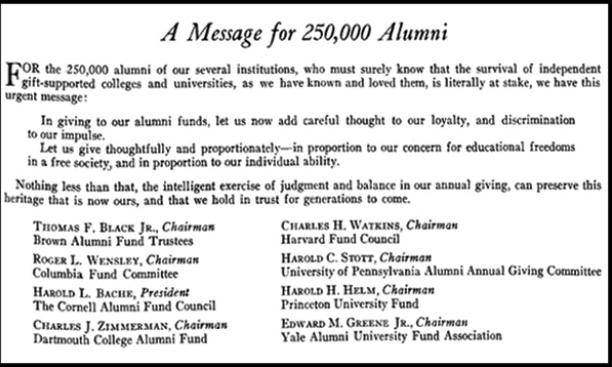
52%
1950-51
A decade later, the participation rate jumps with more than half of the alumni giving.
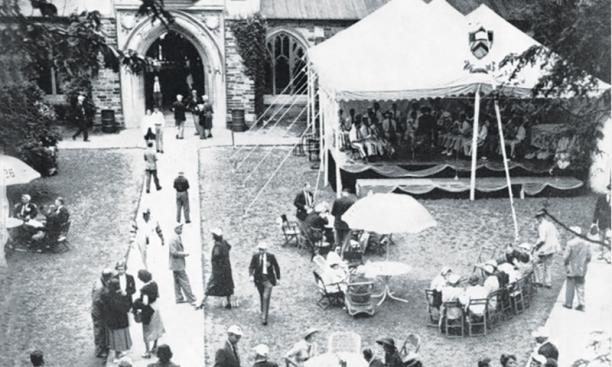
72%
1958-59
Participation reaches a new high, which has never been matched.
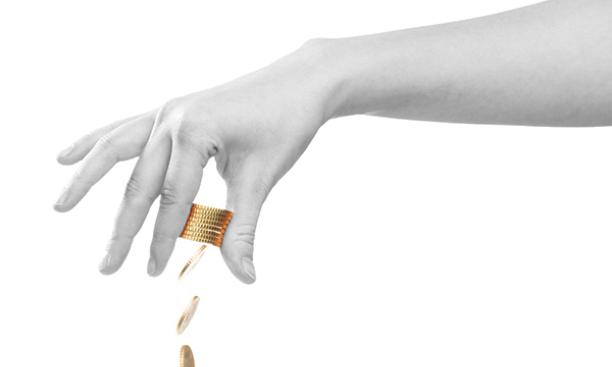
$3 million
1967-68
After starting at $80,000 in 1940-41, giving exceeds $3 million for the first time. Adjusted for inflation, this is the equivalent of $26 million in 2023.
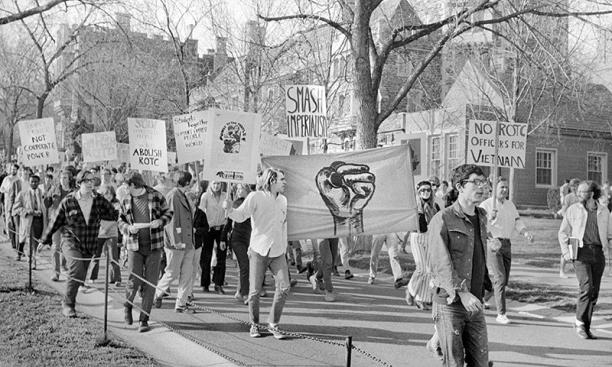
56%
1969-70
Participation drops from 66% in 1967-68 amid the Vietnam War and the start of coeducation.
$17.5 million
1986-87
Giving hits a new high for the 12th year in a row. This total is equal to $46.5 million in 2023.
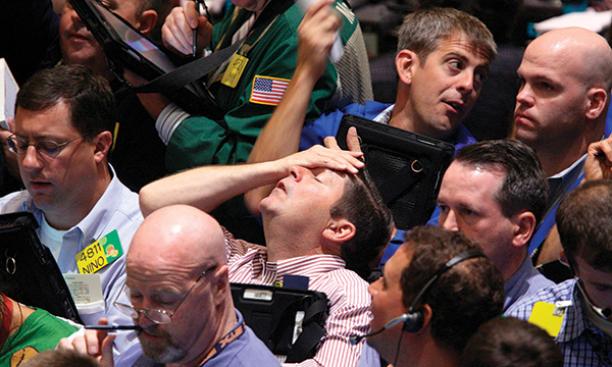
$44.6 million
2008-09
Giving declines by nearly $10 million from the previous year as the Great Recession hits.
47%
2021-22
Participation is at its lowest since 45% in 1949-50.
$81.8 million
2021-22
Giving is at its highest, surpassing the $74.9 million raised in 2016-17.

